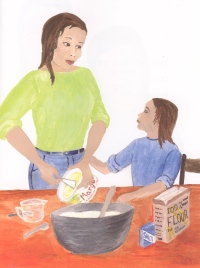| ________________
CM . . .
. Volume XIV Number 5 . . . . October 26, 2007
excerpt:
So begins The Bannock Book written and illustrated by Linda Ducharme. It is a story about a girl who appears to be eight-years-old, her mother, and her grandfather whom she calls Pepere. The mother and daughter are making bannock, and, as they mix the ingredients, changes are made to a recipe Pepere’s mother likely followed. Margarine is substituted for bacon lard, a powered sweetener is used in place of sugar and, after baking, crushed strawberries rather than margarine and sweetened strawberry jam are spread on the “fresh galette” prepared especially for Pepere. Because Pepere is a diabetic, these changes to the traditional recipe are to make a food that is healthier for him.
The Bannock Book is illustrated with Ducharme’s paintings, suggestive of primitive or folk art, that portray the story’s events as well the young girl’s joy, particularly her delight to be helping her mother prepare the dough, patting out her own “little bannocks,” watching the big and little bannocks become fat, puffy, and brown through the glass of the oven door, and finally taking a "big bite." While some young children may not recognize the changes in the physical size, proportion, and overall appearance of the figures portrayed, these transformations may seem strange to those used to more lifelike representations of people. Ducharme has added two pages at the end of the story that contain information for parents, teachers, and other adult readers. The first provides a traditional Metis recipe for bannock as well as the recipe for the bannock prepared in the story. There is also information on how to alter these recipes to make two kinds of dumplings for soups and stews. The second page tells “about diabetes” and the number of diabetics in Canada and suggests ways to reduce the risk of developing diabetes and how diabetics can manage their disease. One way, as the story illustrates, is to use whole grain flours, sugar substitutes, and non-hydrogenated fats in your diet. Many children who have the opportunity to listen to or read this story will likely ask to make bannock. At the very least, they may be encouraged to help in its preparation. This is the story that Ducharme tells. Fortunately, information about diabetes, which young children will not understand, does not get in the way. Recommended. Barbara McMillan is a professor of early years science education in the Faculty of Education, the University of Manitoba.
To comment on this
title or this review, send mail to cm@umanitoba.ca.
Copyright © the Manitoba Library Association. Reproduction for personal
use is permitted only if this copyright notice is maintained. Any
other reproduction is prohibited without permission.
NEXT REVIEW |TABLE OF CONTENTS FOR THIS ISSUE
- October 26, 2007. AUTHORS
| TITLES | MEDIA REVIEWS
| PROFILES
| BACK ISSUES
| SEARCH | CMARCHIVE
| HOME |

